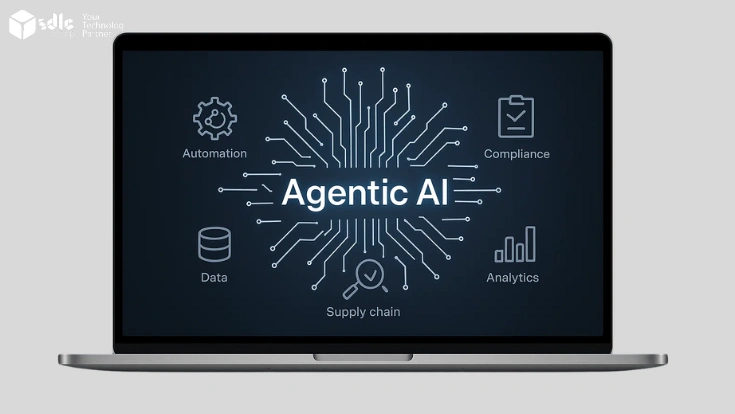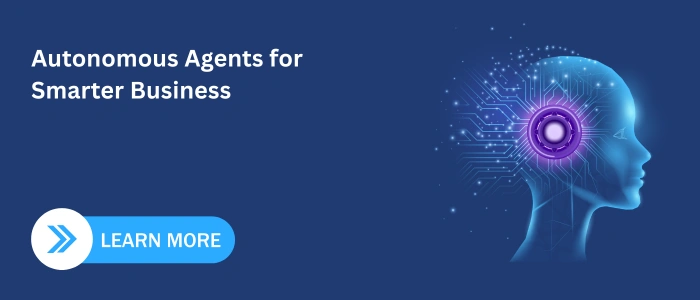Introduction
The way enterprises manage workflows is changing faster than ever. Traditional automation tools can only go so far, but today’s businesses demand systems that think, adapt, and act on their own. This is where the Agentic AI Revolution comes in, powered by autonomous agents that can perceive, plan, execute, and learn without constant human oversight. From manufacturing to finance, these intelligent systems are redefining how work gets done.
For organizations looking to embrace this shift, partnering with an experienced AI development company provides the expertise needed to build and deploy agentic AI solutions that deliver real business value. By combining strategic design with cutting-edge technology, enterprises can unlock automation that doesn’t just save time — it drives measurable growth and resilience.
How Agentic AI Works in Workflows
Agentic AI follows a closed-loop cycle where autonomous agents don’t just execute tasks but also learn and adapt continuously. Many enterprises begin their automation journey with AI & ML implementation services before scaling to agent-driven systems.
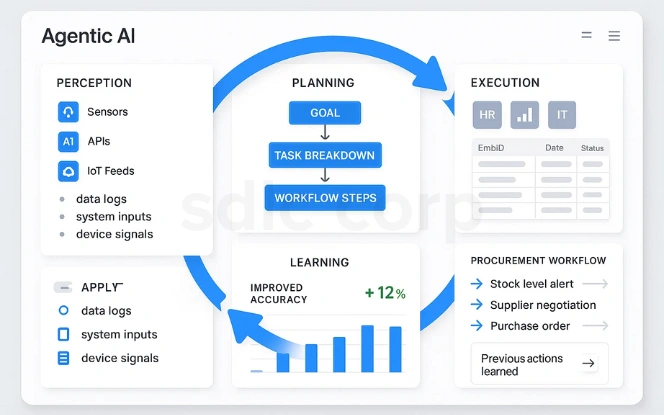
- Perception: Agents gather context from systems, APIs, or IoT devices.
- Planning: LLM-based reasoning engines translate goals into structured steps.
- Execution: Agents perform tasks across ERP, CRM, HR, or IT platforms with minimal oversight.
- Learning: Outcomes are stored in memory layers, helping the system refine future actions.
Example: A procurement agent autonomously monitors stock, negotiates with suppliers, issues purchase orders, and updates ERP records.
Enterprise Use Cases
This shift enables business process automation at scale, where entire workflows are executed with minimal human intervention. Each industry is leveraging agentic AI in different ways, achieving measurable ROI and greater efficiency.
Manufacturing & Supply Chain
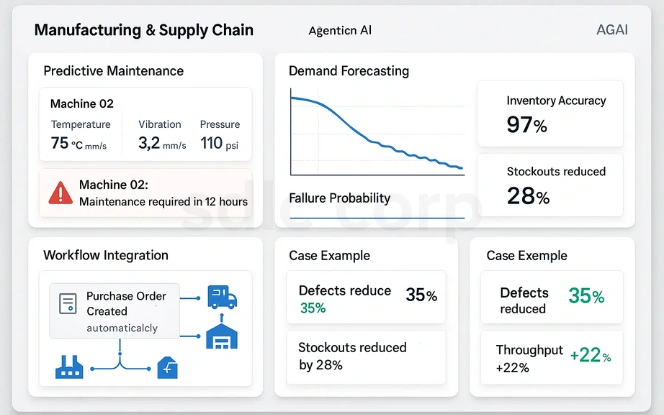
Manufacturers and logistics firms are early adopters of agentic AI, using it to enhance resilience and efficiency across complex operations.
- Predictive Maintenance: Agents analyze IoT sensor data to predict failures before they occur, helping reduce costly downtime and maintenance expenses.
- Demand Forecasting: AI agents balance supply and inventory in real time, ensuring accurate production planning and preventing shortages or overstock.
- Case Example: A global manufacturer reduced defects by 35% and increased throughput by 22% after deploying agent-driven quality checks.
Read more – Generative AI for Supply Chain
Finance
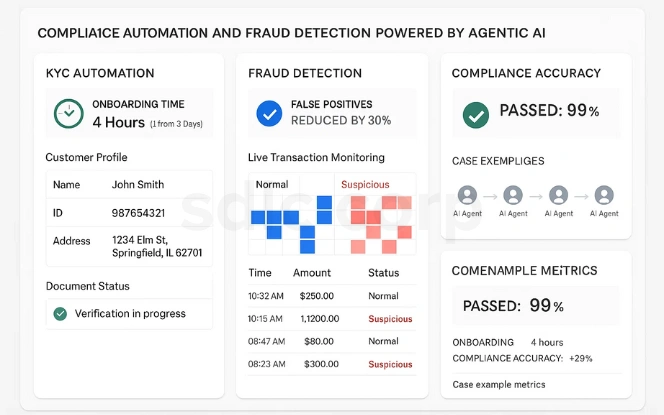
The financial sector utilizes AI agents to streamline compliance-intensive processes and enhance security.
- KYC Automation: Automates identity verification and document checks, reducing onboarding from days to hours while ensuring regulatory compliance.
- Fraud Detection: Identifies complex transaction patterns with higher accuracy, significantly reducing false positives and fraud losses.
- Case Example: A leading bank cut client onboarding time to just 4 hours while improving compliance accuracy.
Healthcare
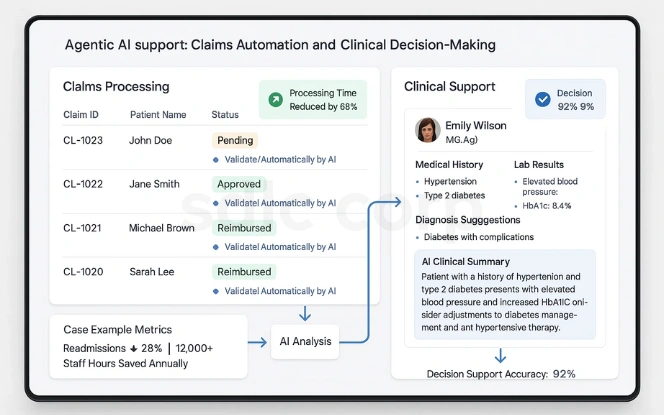
Healthcare organizations are integrating agentic AI to cut administrative workloads and improve patient outcomes.
- Claims Processing: Automates claim validation and reimbursements, freeing up staff and speeding up payment cycles.
- Clinical Support: Summarizes medical records, lab results, and patient histories, enabling faster, more accurate clinical decisions.
- Case Example: Hospitals reduced readmissions by 28% and saved over 12,000 staff hours annually by adopting AI-driven coordination.
Read more- Generative AI for Healthcare
Retail & E-commerce
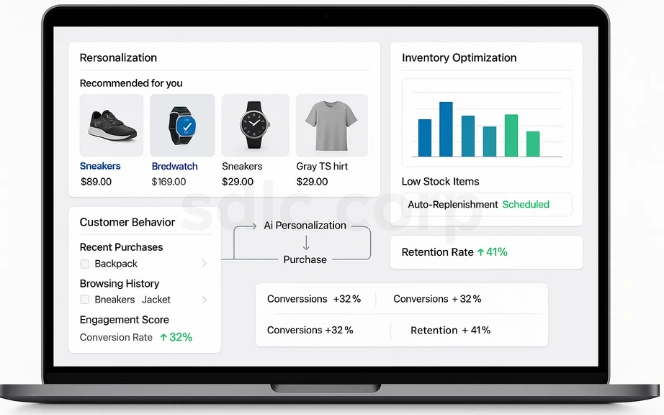
Retailers deploy AI agents to enhance customer experiences and optimize supply chains.
- Personalization: Delivers real-time product recommendations based on customer behavior, increasing engagement and conversion rates.
- Inventory Optimization: Uses predictive algorithms to automate replenishment, preventing stockouts and ensuring consistent availability.
- Case Example: A Fortune 100 retailer increased conversions by 32% and boosted customer retention by 41% with AI-powered personalization.
Read more – Generative AI for Retail
Professional Services
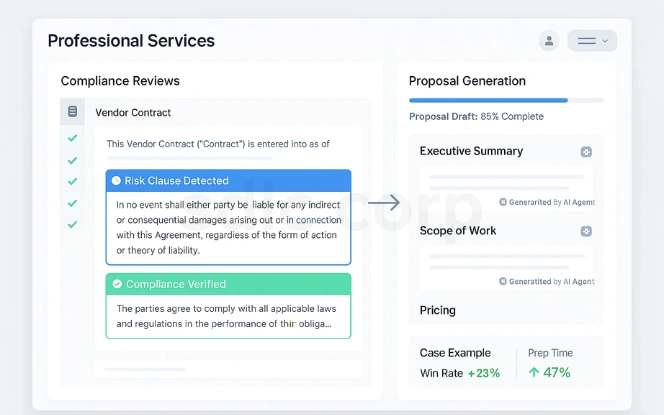
Service-based businesses leverage agentic AI to accelerate knowledge-heavy and compliance-driven workflows.
- Compliance Reviews: Automates the analysis of contracts, reports, and regulatory documents, reducing the manual workload for experts.
- Proposal Generation: Speeds up proposal drafting by pulling insights from enterprise knowledge bases, improving both quality and turnaround times.
- Case Example: A consultancy reduced proposal preparation time by 47% and increased win rates by 23% using autonomous agents.
Agentic AI vs Traditional Automation
| Feature | Traditional RPA / BPA Tools | Agentic AI |
|---|---|---|
| Logic | Runs fixed scripts only | Uses reasoning to adapt dynamically |
| Flexibility | Breaks when workflows change | Replans automatically |
| Scope | Limited to single tasks | End-to-end workflow execution |
| Memory | Stateless, no context | Retains memory for smarter actions |
| Error Handling | Manual fixes required | Detects and self-heals errors |
| Learning | No improvement over time | Continuously optimizes performance |
Challenges Enterprises Must Address
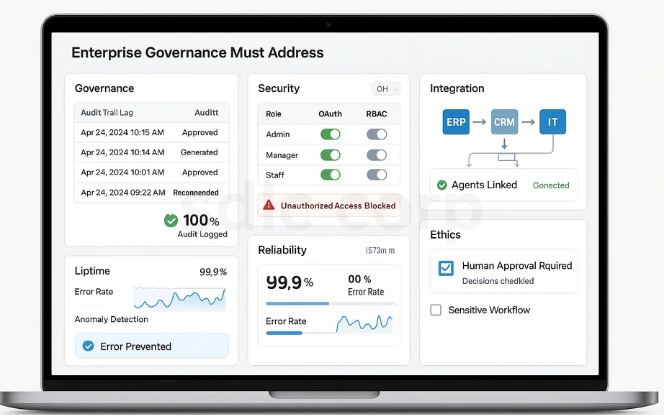
While agentic AI delivers transformative benefits, enterprises must also navigate key challenges to ensure responsible, reliable, and secure adoption.
- Governance: Transparent audit trails are necessary to track every AI-driven decision, ensuring compliance with internal policies and external regulations.
- Security: Strict access controls such as OAuth and RBAC must be applied to safeguard sensitive enterprise systems and prevent misuse.
- Integration: Effective orchestration is required to connect agents with ERP, CRM, and IT infrastructure without disrupting existing workflows.
- Reliability: Guardrails, validators, and monitoring systems are essential to minimize errors and prevent unintended outcomes.
- Ethics: Human-in-the-loop oversight must remain in place for regulated workflows, protecting organizations from ethical and legal risks.
Enterprise Implementation Roadmap
A structured rollout ensures that agentic AI adoption is smooth, scalable, and delivers measurable results. Enterprises can follow these key phases:
- Identify High-Impact Use Cases – fraud detection, claims, or compliance.
- Pilot Deployment – test agents in controlled projects.
- Department Scaling – extend into finance, HR, and supply chain.
- Governance Framework – add monitoring and compliance oversight.
5. Enterprise Rollout – build multi-agent ecosystems across functions.
KPIs for Measuring Success
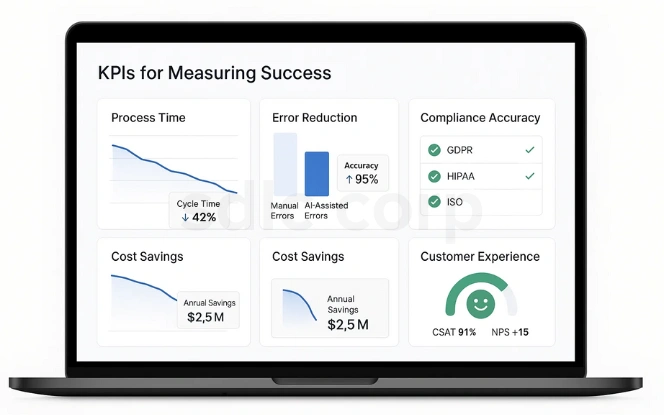
To evaluate the impact of agentic AI, enterprises must track clear performance indicators that show both efficiency gains and business value.
- Process Time: Measure reductions in workflow cycle speed to confirm that agents are streamlining operations and delivering faster outcomes.
- Error Reduction: Track decreases in manual or system mistakes, ensuring that automation improves accuracy instead of introducing new risks.
- Compliance Accuracy: Monitor alignment with industry regulations and audit standards, confirming that automated processes remain reliable and compliant.
- Cost Savings: Calculate reductions in operational expenses per workflow to validate financial ROI from automation.
- Customer Experience: Review improvements in CSAT, NPS, or retention rates to measure the impact of AI-driven workflows on end users.
Vendor Landscape
Generative AI is giving fashion companies more than just speed and efficiency it’s helping them reinvent how they work and connect with customers. Here are some of the biggest benefits:
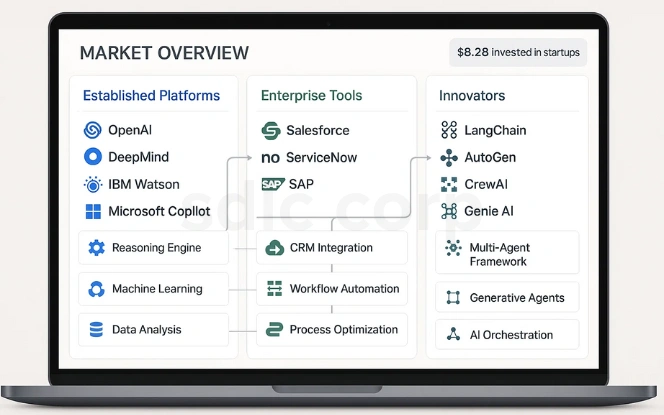
The ecosystem of agentic AI is evolving quickly, with established providers, enterprise-focused platforms, and innovative startups shaping the market.
- Established Platforms: Leaders like OpenAI, DeepMind, IBM Watson, and Microsoft Copilot focus on core AI models, reasoning engines, and productivity integrations that power intelligent agents.
- Enterprise Tools: Platforms such as Salesforce Agentforce, ServiceNow AI, and SAP AI Core deliver end-to-end enterprise integration, helping businesses embed agents directly into existing workflows.
- Innovators: Startups including LangChain, AutoGen, CrewAI, and Genie AI are driving rapid innovation with open frameworks and modular tools that enable flexible, multi-agent system development.
Future Outlook
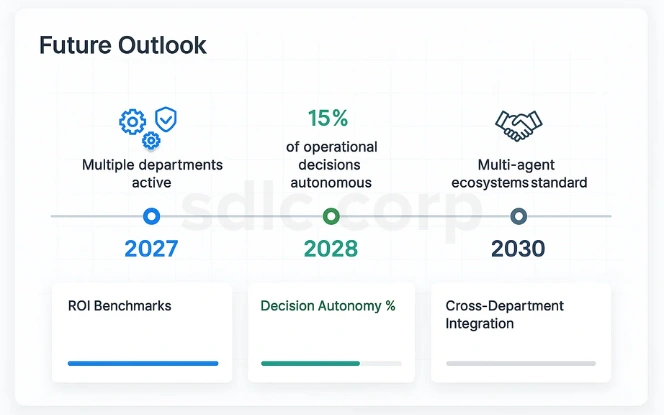
The adoption of agentic AI is accelerating rapidly, with enterprises moving from pilot projects to enterprise-wide transformation. The next decade will define how deeply autonomous systems reshape business operations.
- By 2027: Enterprises will deploy agents across multiple departments, delivering measurable ROI in compliance, customer service, and supply chain operations. Early adopters will set benchmarks for efficiency.
- By 2028: Roughly 15% of operational decisions will be handled autonomously, especially in high-volume, rule-based workflows like fraud detection, claims, and routine financial approvals.
- By 2030: Multi-agent ecosystems will become the standard, with specialized agents collaborating seamlessly across finance, HR, IT, and customer workflows to run adaptive, intelligent enterprises.
Conclusion
The Agentic AI Revolution is transforming enterprise operations, turning static workflows into adaptive, intelligent systems that continuously improve. By leveraging autonomous agents, businesses can achieve higher efficiency, accuracy, and resilience while positioning themselves ahead of competitors.
Those who act now will lead the next wave of digital transformation. To accelerate this journey, enterprises can hire AI developers with expertise in building agent-driven solutions that align with their specific goals and workflows.
Related Blogs You Should Explore:
FAQ's
How Is Agentic Ai Different From Rpa?
RPA follows rigid scripts, while agentic AI reasons, adapts, and learns to handle evolving enterprise workflows.
Which Frameworks Support Agentic Ai?
Tools like LangChain, AutoGen, and CrewAI power multi-agent systems, often combined with orchestration platforms for scalability.
Which Industries Are Early Adopters?
Finance, healthcare, retail, supply chain, and professional services are leading adoption due to high transaction volumes.
Can Agentic Ai Replace Employees?
No. It automates repetitive tasks, while employees focus on oversight, innovation, and strategic decision-making.
How Secure Is Agentic Ai For Sensitive Data?
When deployed with governance, audit trails, and access controls, agentic AI is secure even for regulated industries.

